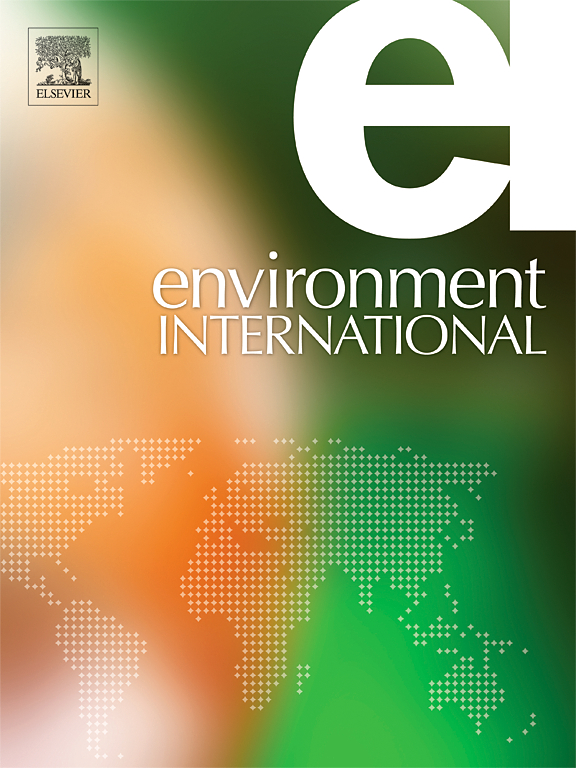An exposomics analysis of 125 biomarkers of exposure to food contaminants and biomarkers of oxidative stress: a randomized cross-over chrononutrition trial of healthy adults
IF 10.3
1区 环境科学与生态学
Q1 ENVIRONMENTAL SCIENCES
引用次数: 0
Abstract
Background
Contaminants in food counteract the beneficial effects of nutrients by interfering with their absorption/distribution/metabolism/excretion characteristics and implicated in chronic disease pathogenesis. The CIRCA CHEM chrononutrition trial was used to expand and replicate its earlier results from two biomarkers of exposure to pesticides to 125 biomarkers of exposure to food contaminants/xenobiotics, using exposomics.Objectives
We determined i) the effect of time restricted eating (TRE) consumption of fruits and vegetables either in light or dark phases of the 24-h period (five-a-day portions for 14 days), within ad libitum diet on 125 biomarkers of exposure to food-associated contaminants in healthy adults, ii) the chrono-metabolism patterns in biomarker concentrations across/within treatment phases (light vs dark); and iii) the contaminants associated with oxidative stress, including 4-hydroxy-2-nonenal mercapturic acid (HNEMA) and 8-iso prostaglandin F2α (F2A8IP).Methods
We characterized the temporal patterns of the TRE treatment effectiveness on biomarkers of exposure using an exposome-wide association study (ExWAS) approach, by applying linear mixed-effects models (LME) to evaluate treatment phase effects and interactions of treatment x time. Associations between contaminants and oxidative stress were further explored using LASSO regression, followed by additional LME, while adjusting for sociodemographics, body mass index and cortisol.Results
A wide within-subject concentration variability for most biomarkers of exposure to food contaminants/xenobiotics was observed. The ExWAS approach confirmed that TRE significantly influenced the concentration and temporal patterns of multiple food contaminants/xenobiotics, including pesticides, smoking, volatile organics, phytoestrogens, parabens, and flame retardants, demonstrating their chrono-differentiated metabolism, depending on the timing of fruit and vegetable consumption within the 24-h period. Some of them (pesticides and VOCs) exhibited significant associations with lipid oxidative stress.Discussion
Understanding how the circadian rhythm interacts with metabolic systems to influence the metabolism of both nutrients/bioactives and food contaminants would be of high importance in the era of precision health and precision nutrition125个食物污染物暴露生物标志物和氧化应激生物标志物的暴露组学分析:健康成人随机交叉时间营养试验
食物中的污染物通过干扰营养物质的吸收/分布/代谢/排泄特性来抵消营养物质的有益作用,并与慢性疾病的发病机制有关。CIRCA CHEM时间营养试验使用暴露组学扩展和复制了其早期的结果,从暴露于农药的两个生物标志物扩展到暴露于食品污染物/外源物的125个生物标志物。我们确定了i)限时进食(TRE)在24小时内的光照阶段或黑暗阶段(每天5次,持续14 天)在自由饮食中食用水果和蔬菜(TRE)对健康成年人暴露于食物相关污染物的125个生物标志物的影响,ii)生物标志物浓度在治疗阶段/治疗阶段(光照与黑暗)的时间代谢模式;iii)与氧化应激相关的污染物,包括4-羟基-2-壬烯醛巯基酸(HNEMA)和8-异前列腺素F2α (F2A8IP)。方法采用全暴露关联研究(ExWAS)方法,通过线性混合效应模型(LME)评估治疗阶段效应和治疗 x 时间的相互作用,表征了三氟化碳治疗对暴露生物标志物的有效性的时间模式。污染物与氧化应激之间的关系使用LASSO回归进一步探讨,随后是额外的LME,同时调整社会人口统计学,体重指数和皮质醇。结果观察到大多数暴露于食品污染物/外源物的生物标志物在受试者体内的浓度差异很大。ExWAS方法证实,TRE显著影响多种食品污染物/外源物的浓度和时间模式,包括农药、吸烟、挥发性有机物、植物雌激素、对羟基苯甲酸酯和阻燃剂,显示出它们的时间分化代谢,取决于24小时内水果和蔬菜消费的时间。其中一些(农药和挥发性有机化合物)与脂质氧化应激有显著相关性。在精确健康和精确营养的时代,了解昼夜节律如何与代谢系统相互作用以影响营养物质/生物活性物质和食物污染物的代谢将具有重要意义
本文章由计算机程序翻译,如有差异,请以英文原文为准。
求助全文
约1分钟内获得全文
求助全文
来源期刊

Environment International
环境科学-环境科学
CiteScore
21.90
自引率
3.40%
发文量
734
审稿时长
2.8 months
期刊介绍:
Environmental Health publishes manuscripts focusing on critical aspects of environmental and occupational medicine, including studies in toxicology and epidemiology, to illuminate the human health implications of exposure to environmental hazards. The journal adopts an open-access model and practices open peer review.
It caters to scientists and practitioners across all environmental science domains, directly or indirectly impacting human health and well-being. With a commitment to enhancing the prevention of environmentally-related health risks, Environmental Health serves as a public health journal for the community and scientists engaged in matters of public health significance concerning the environment.
 求助内容:
求助内容: 应助结果提醒方式:
应助结果提醒方式:


